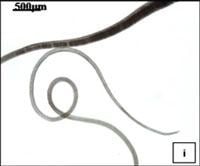Subclass Enoplia Rank Species | Phylum Nematoda Order Trichurida Genus Trichuris Higher classification Trichuris | |
 | ||
Similar Trichuris, Roundworms, Heligmosomoides polygyrus, Nippostrongylus brasiliensis, Trichuris suis | ||
Visualising the parasitic whipworm trichuris muris using x ray micro computed tomography
Trichuris muris is a nematode parasite of mice. It is very similar to the human roundworm parasite Trichuris trichiura due to its immunological reactivity when crossed, and so is often used in related studies. Ingesting material that contains embryonated eggs allows for transmission and infection to occur. The eggs travel down to the cecum - a pouch located at the start of the large intestine - where larval hatching is induced. The larvae proceed to penetrate through the mucosal epithelium, then molt into their secondary stage of infection after 9–11 days. Seventeen days after infection, the larvae arrive at the tertiary stage followed by a quaternary molt 5 days later. The larvae complete their last molt 29 days post-infection and transform into mature dioecious adults. These whipworms utilize their anterior ends to embed themselves into the cells that line the walls of the large intestine. After establishing their place in the intestinal wall, the adult worms mate and release unembryonated eggs into the environment via the feces.
Contents
- Visualising the parasitic whipworm trichuris muris using x ray micro computed tomography
- Trichuris muris
- References
According to research conducted by Hayes et al., T. muris relies on direct contact with intestinal bacteria in order to promote hatching of the embryonated eggs. Using green fluorescent protein (GFP) and E. coli strains, the authors were able to observe that the bacteria gathered specifically around the opercula, which are located at the poles of the eggs. The bacteria contain type 1 fimbriae, which possess adhesin FimH at their fimbrial tips. FimH interacts with a mannosylated receptor found on the egg's surface. When bound, a signal transduction cascade is triggered and results in the worm emerging from the egg. Temperature, in particular at 37°C, served as an additional hatching cue - this specific temperature is thought to prevent T. muris eggs from hatching in unideal outside environments.
The relationship between T. muris and bacteria also has a significant effect on the host's immune response. In the article Exploitation of the Intestinal Microflora by the Parasitic Nematode Trichuris muris, authors K.S. Hayes et al., treated AKR and SCID (severe combined immunodeficient) mice with enrofloxacin, a fluoroquinoline antibiotic, in order to observe potential effects on worm establishment. The activation of type 2 helper cells (Th2) is decreased in the presence of antibiotics because there are fewer whipworms binding to the intestinal walls. This in turn drives up the proliferation and differentiation of Th17 and Th1 cells. Eighteen days after infection, the worm burden in antibiotically-treated mice was drastically reduced (P<0.001), further supporting the notion that bacteria are essential to the worms' establishment.
